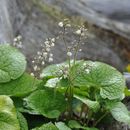en
names in breadcrumbs


Flowering from May to August; Fruiting from July to September.
Beesia calthifolia is close relative of Beesia deltophylla, but differs from the latter in its leaves reniform, cordate, or orbicular-ovate (vs. cordate-triangular), margin with 40-50 teeth on each side (vs. 7-16 teeth on each side), teeth relatively small, 2-4 mm wide at base (vs. teeth relatively large, 3-8 mm wide).
Beesia calthifolia is occurring in S Gansu, N Guangxi, Guizhou, W Hubei, W Hunan, S Shanxi, Sichuan, NW Yunnan of China, N Myanmar.
Systematic position of Beesia was inferred from the internal transcribed spacers (ITS) gene (Wang et al., 1998). Results show that a monophyletic group comprising Beesia calthifolia, Cimicifuga acerina, Cimicifuga brachycarpa and Actaea asiatica is strongly supported by the bootstrap value. In the monophyleticn group, Beesia calthifolia is basal to the other three species. The present DNA sequence analysis demonstrates that the genus Beesia should be placed in the tribe Cimicifugeae, which is consistent with the results from phytochemistry, palynology and cytology. In addition, Beesia may be the most original genus in the tribe Cimicifugeae in view of simple leaf, apetalous flower and molecular evidence.
Rhizome to 10 cm, 3-7 mm in diameter. Scapes more than 14 cm, to 58 cm at fruiting, basally glabrous, apically densely pubescent. Basal leaves 2-4, long petiolate; petiole 10-26 cm long, slightly widened, glabrous; leaf blade reniform, orbicular-ovate, or deeply cordate at base, 4.5-9.5 cm long, 5.5-16 cm wide, both surfaces glabrous, rarely pubescent abaxially at veins, margin dense with 40-50 teeth on each side, apex rounded, shortly acuminate, or acute. Inflorescence cymose, 5.5-9.5 cm long, 1.5-2.5 cm wide; bracts usually subulate, sometimes lanceolate, rarely spatulate, 1-1.5 mm long, glabrous. Pedicel 5-10 mm long, densely spreading pubescent. Sepals white or pinkish, narrowly ovate or elliptic, 3-5 mm long, 1.8-2.5 mm wide, glabrous, apex acute or blunt. Stamens shorter than sepals; anthers ca. 3 mm in diam. Follicle 1.1-1.7 cm long, flat, lanceolate-linear, middle part curved, lower part 3-4 mm wide, sparsely pubescent near base, otherwise glabrous, with ca. 8 obliquely transverse veins; persistent style 1-2 mm. Seeds several, ca. 2.5 mm, obliquely corrugate.
The chromosomal number of Beesia calthifolia is 2n = 16, 32 (Shang, 1985; Yang, 1999).
Growing in wet places in valleys, forests; 1400-3500 m.
Beesia calthifolia of rhizomes are used medically to treat rheumatic pain, influenza, and swelling.